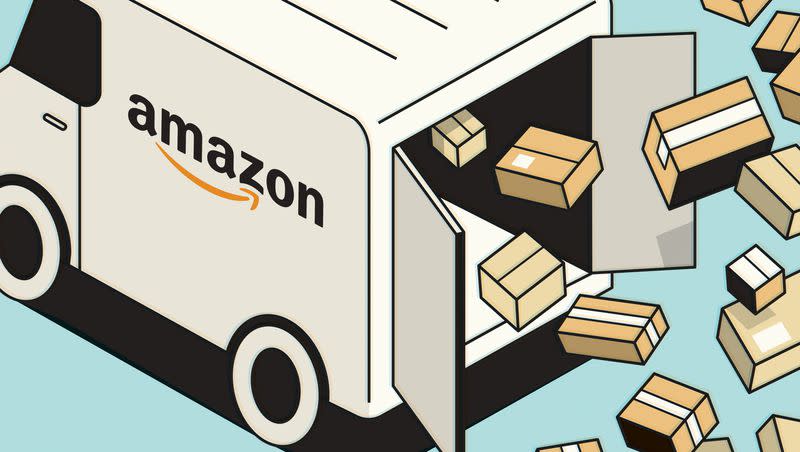Point-counterpoint: Is Amazon past its prime?

Move over, Santa. Amazon runs the holidays now. The dot-com behemoth captured two-thirds of online gift shoppers in 2022, nearly doubling up its closest competitor. More generally, the Seattle company controls nearly 38% of American e-commerce, leaving just 7% for second-place Walmart, and even beat out NATO, the CDC and the Supreme Court in a 2021 survey ranking the country’s most favorably-viewed institutions. But Amazon is also the target of a landmark antitrust lawsuit filed in September by the Federal Trade Commission and 17 state attorneys, alleging monopolistic practices used to “inflate prices, degrade quality and stifle innovation.” And 56% of small business owners told Lendio surveyors they see Amazon as a threat. Is Jeffrey Bezos’ beloved e-tailer a friend or foe?
A Heavyweight Partner
Amazon is a boon for small businesses, retail partners that form the backbone of the company’s operation. While the company does sell directly to consumers, the idea that it is competing with retailers is largely a misconception. Unlike Walmart and the other big-box stores that decimated Main Streets across America, Amazon is not primarily a retailer but a platform for third-party sellers. In exchange for access fees and commissions, the company not only lets them access the largest customer base on Earth but also provides a range of services empowered by its massive economies of scale.
To put it simply: Amazon claims about 200 million members in its Prime program, which provides a streaming service as well as free shipping and returns on many products for a monthly subscription fee. That’s equivalent to more than half the population of the United States, all shoppers who can select for Prime-enabled products when they search — making the company a preferred resource for cost-conscious members. “If you’re on Amazon, a lot of people can easily find the products that you’re selling,” says Mark Jamison, business professor at the University of Florida and a fellow at the American Enterprise Institute.
Amazon can also handle the “grunt work” of retail, like returns and exchanges, or centralize customer service. Sellers can also enroll in “Fulfillment by Amazon” to piggyback on the company’s substantial warehouse space and shipping infrastructure, so when a customer orders from that seller, Amazon already has the product on hand and ready to ship. “For a company simply looking to start selling quickly and outsource a lot of the logistics involved in retail,” Marc Bain wrote for Quartz, “Amazon can be attractive.”
Since Amazon makes most of its money not by selling its own products, but by taking a cut of third-party sales, it wants to see those sellers succeed. “If that’s the core of your business, you want them to be successful, to be rewarded,” Jamison says. “The surveys that I have seen where small businesses say Amazon is a threat, it’s largely because they’re not using Amazon.”
A bully is a bully
The free market is fueled by healthy competition, as embodied by Adam Smith’s “invisible hand.” The economist used this metaphor to describe market forces fueled by rational self-interest that he argued would push businesses to the optimal intersections of supply and demand, cost and benefit. But in its own marketplace, Amazon behaves more like a fist, jabbing rivals until they are too weak to fight back.
The platform is not designed for businesses to develop brand recognition. Presented like a catalog, the site standardizes every detail but the company’s name. And sellers find themselves at the mercy of a provider that changes policies on a dime, charging sellers to appear among top search results or adding new fees, like one imposed earlier this year that seems to punish sellers who ship their own products. Amazon has also increased its cut of third-party sales, surpassing 50% on average in 2022. “It is prohibitively expensive for small businesses to do business there,” says Kennedy Smith, senior researcher with the Institute for Local Self-Reliance.
Sellers also confront a marketplace that is not only saturated with nearly every imaginable version of each product, but itself produces knockoffs when products are successful. According to a 2020 report by the House antitrust subcommittee, Amazon harvests data on its bestselling items so that it can copy them and sell its own versions at lower prices under unfamiliar brand names — alongside independent knock-offs. “Amazon is first and foremost a data company,” one former employee told House investigators, “they just happen to use it to sell stuff.”
Adam Smith is often evoked to support opposition to government interference in the economy, but the father of modern capitalism also worried about a company accumulating too much power. When that company can distort the entire market for their advantage, we call it a monopoly. “Amazon is so dominant a sales platform that the odds of a small business attracting sales to its own platform are miniscule,” says Kennedy Smith. “So their sales are going to be sort of truncated right out of the gate.”
This story appears in the December issue of Deseret Magazine. Learn more about how to subscribe.

